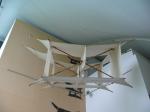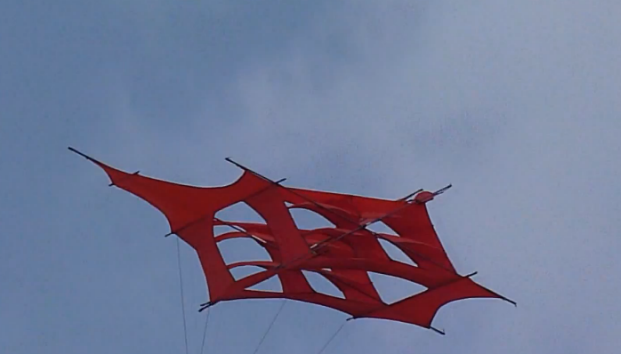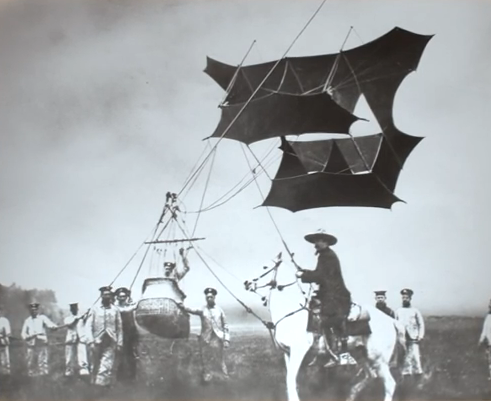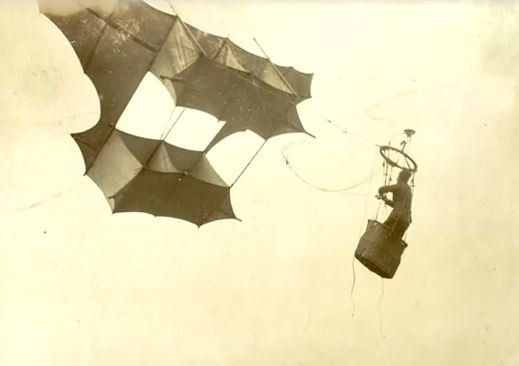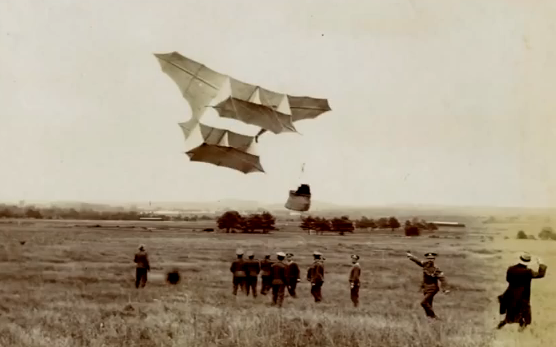Cody Man Lifting Kite 1906 Hendon
English Translation
Historique Voir ICI
History Click HERE
Cody's Kites and Flying Machines
Kites
Cody began experimenting with man-lifting kites and by 1901 he had offered his inventions to the British War Office. He knew that during the Boer War the British Army had used observation balloons, but that they took hours to inflate and were useless in winds.
In November 1902 Cody's patent for a man-lifting kite was accepted and in the following February he offered his designs to the British Navy, although they eventually turned down his designs.
Cody also spent some time working on a kite boat in which he crossed the English Channel in 1903. In June 1904 Cody came to Aldershot to test his kites, in collaboration with the Army where he was temporarily on a salary of £1000 per year and expenses at the rate of lieutenant. He worked on balloons, kites and aeroplanes.
In September 1907 the war airship, Nulli Secundus, was unveiled at Aldershot. After completing two circuits of Farnborough Common at a height of 800 feet, it was immediately hailed a success.
His career with the Army looked like it was over in February 1909. However, after much lobbying, the authorities at Aldershot Garrison were persuaded to acknowledge Cody's ownership of his plane and gave him permission to base his workshop at Laffan's Plain. Cody spent many hours testing his aircraft over the skies of Farnborough whilst large crowds gathered to watch him.
Flying Machines
By late 1907 Cody had begun plans for his first aeroplane. Code-named British Army Aero Plane No.1, it had 40 foot wings, bicycle wheels on the wing tips and a revolutionary buffer wheel.
Cody's 1909 plane became known as 'The Flying Cathedral' because of the French term 'katahedral' referring to the curvature of the biplanes wings. The Mk II Cathedral was originally fitted with two engines but these proved to be unsuccessful so Cody used just one engine instead.
It was this plane which Cody entered in the 1910 Michelin Cup. The Cathedral came to an untimely end when a trainee pilot caused it to crash at Laffan's Plain in December 1911. However, by 1912 Cody had been able to install an Austro-Daimler engine and the Cathedral Mk III was now capable of carrying up to four passengers at a time.
During the winter of 1911, Cody began designs for a monoplane which by Spring 1912 was reaching speeds of 80 miles an hour. Cody had plans for an air ambulance for the Royal Army Medical Corps. His Cathedral was able to carry a table, doctor, assistant and anaesthetist. Cody's final aircraft, the water-plane, had a 60 foot wingspan. He practiced floating the plane on the Basingstoke Canal near Laffan's Plain. The aircraft could also be fitted with wheels in place of the floats.
Cody's achievements
Army Aeroplane No.1 (above) designed and piloted by Cody, was the first plane to fly in Britain. On 16 October 1908 Cody flew almost 1,400 feet in 27 seconds to an altitude of 30-40 feet towards Cove Common.
On 14 August 1909, Cody took the first passenger up in his aircraft. Waiting for them to return was Lela Cody (right) who was preparing herself for her first flight as a passenger
An early morning flight on 8 September 1909 lasted for 63 minutes and Cody for a distance of over 40 miles. Louis Bleriot held the official world record for a cross-country flight covering 25 miles.
The first air show in Britain was held 1909. Cody completed one lap of the circuit. The plane crash landed but Cody escaped unhurt. It was here that he also became a British citizen.
Cody's set a new British distance record of 189.2 miles in the 1910 Michelin Cup. Cody won both Michelin prizes in 1911 completing 255 miles in one single flight setting a new British record and completing a 125-mile cross-country circuit in just over three hours.In July 1912 Cody's plane was one of 32 entered in the Military Flying Trials at Salisbury Plain. Cody's Cathedral Mk III won both of the top prizes. Due largely to his success at Salisbury, the Royal Aero Club awarded Cody the Gold Medal, its highest honour, in the summer of 1912.
Accidents and death
Cody suffered a number of accidents from cowboy stunts to his untimely death. On one occasion he fell from his man-lifting kite badly breaking his arm and almost drowned when testing kites for the Admiralty. In 1912 his plane hit the ground at approximately 75 miles per hour and he suffered a severe blow to the head. Later that year Cody had another crash when the engine cut out suddenly at 2000 feet. As he glided to earth the plane collided with a cow !
Cody's death occurred on 7 August 1913 at Cove Common. As his plane passed over Ball Hill the wings crumpled and it's passengers were hurled 500 feet to the ground. Death was instantaneous.
'I have received with profound regret the news of the death of Mr. Cody... his loss will be much felt at Aldershot where he did so much for military aviation.' Telegram received from George V
His funeral, with the highest military honours, was held on 11th August 1913. Approximately 100,000 people lined the route as the coffin passed by on a gun carriage. There were many theories on the cause of the crash including rumours of spies and sabotage. As eyewitness accounts varied the inquest never reached a final verdict. The Royal Aero Club claimed it was a structural weakness in the aircraft but many were doubtful and theories still abound today.
As a memorial to Cody there is an aluminium replica of the beech tree that Cody used to tether his planes to, whilst testing engine thrust on Laffan's Plain. It can be seen outside the Cody Building of the Defence Evaluation Research Agency (QinetiQ), the successor to the Royal Aircraft Establishment.
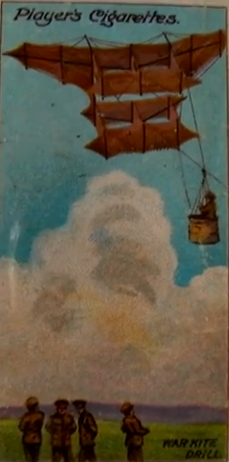 |
| Usage Militaire |
Voir Aussi Autre Photoscope See Also Other Walk Around
Dirigeable Nullis Secondis






.JPG)
.JPG)
.JPG)
.JPG)
.JPG)
.JPG)
